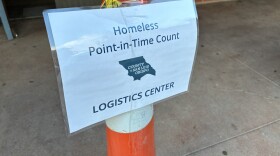This piece was produced as a project for the USC Annenberg Center for Health Journalism’s 2023 Data Fellowship.
The harsh reality of homelessness is a world of constant trauma. Exposed to the elements and forced to inhabit places unfit for living, unsheltered people often endure theft, violence and other horrors.
According to the 2022 Point-in-Time Count, almost half of San Luis Obispo County's homeless population who answered a question about PTSD, or post-traumatic stress disorder said they had the condition.
PTSD and the trauma of homelessness can create a reinforcing cycle that makes seeking help more difficult.
Lori Eister, a therapist with Transitions-Mental Health Association, or TMHA, explained how long-term homelessness can even cause people to develop C-PTSD, a more severe form of the disorder.
“Complex PTSD means that this person has been through repeated chronic trauma over and over,” Eister said.
According to Eister, the longer someone is homeless, the more trauma they experience, which can lead to C-PTSD symptoms such as depression, aggressiveness and dissociation.

On a recent outing with the City Mobile Crisis Unit, I accompanied staff to check up on Daniel Brainerd, who has been homeless for roughly a decade. As we approached, he sat up sullenly in his sleeping bag.
“You’re catching me at a real melancholy point in time,” Brainerd said.
He shared that he was going through a tough time, mourning the loss of a friend. Curious about Brainerd’s future plans, I asked if he intended to seek help.
“No,” Brainerd quickly responded.
“Every time I try, I get shot down, and that is demoralizing, depressing and makes you suicidal, so I don't try,” he said. “No ambitions — no disappointment.”
People, like Brainerd, who have faced long-term homelessness, may develop what Eister referred to as a "failure response."
“It's where people have been down for so long that they expect to fail at things,” Eister said.
When someone experiencing homelessness exhibits a failure response, they often avoid seeking help and resources. This can prolong their homelessness, exposing them to more trauma and worsening their mental health.
According to Eister, a failure response can also cause people who are no longer unhoused or are close to getting back on their feet to slip back into homelessness.
“They'll get almost to success,” Eister said. “They'll almost get that job, or they'll have almost 30 days clean and sober, but then they'll blow it up.”
Eister explains that the interplay of trauma, PTSD and failure response can create a cycle of recurring homelessness.
In the PIT survey, people who reported having PTSD were over 40% more likely to report being homeless more than once than those without the disorder.

“They're not going to be able to keep a job; they're not going to be able to keep relationships; they're not going to be able to keep income, and all of these things just return them back to homelessness over and over,” Eister said.
Some people manage to break free from the cycle. Chad Lamb, who experienced homelessness on-and-off for about 15 years, now lives in TMHA supportive housing.
He’s finally being treated for PTSD stemming from chronic child abuse, but it took many "almosts" for him to reach this point.
Lamb remembers the first time he stayed sober for two weeks. It was a turning point for him after struggling with addiction for years. But he relapsed while grieving the loss of his friend.
“It’s the fact that I actually had a connection with another human being, so it affected me really bad,” Lamb said.
Lamb constantly faced tragic events like loss and violence while living outside. Existing in survival mode made it difficult for him to consider seeking help for his mental health and substance abuse issues.

Crystal Racicot, a program manager with TMHA, works closely with clients like Lamb. She shares a personal connection to the cause, having once been homeless herself while battling PTSD from an abusive relationship.
Despite these challenges, Racicot eventually found her way to County Mental Health Services, where she received the support she needed.
“It's not an easy thing to get into County Mental Health because you have to make all those appointments. They also cancel,” Racicot said. “It's a different doctor every time you go there, and so you have to start your story over again.”
Racicot also noted that people who are already dealing with trauma and exhaustion often struggle to keep track of their appointments.
“The main barrier I see with homelessness is lack of phones, lack of being able to wake up at normal times, and not knowing what time it is during the day to make their appointments,” Racicot said.
In spite of facing mental and physical barriers, Lamb was able to access services and is grateful to TMHA for helping him get on the right path.
The last part of this series will delve into how local mental health services are actively helping homeless people break free from the cycle.
This piece was produced as a project for the USC Annenberg Center for Health Journalism’s 2023 Data Fellowship.







